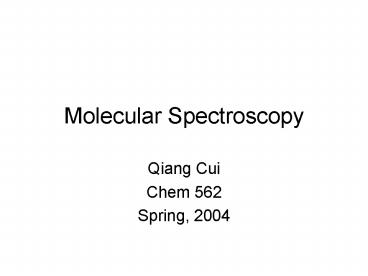Molecular Spectroscopy
1 / 32
Title: Molecular Spectroscopy
1
Molecular Spectroscopy
- Qiang Cui
- Chem 562
- Spring, 2004
2
Powerful analytical tool
3
Atomic spectroscopy
n4
n3
n2
Ef-Eihn
n1
N. Bohr (1885-1962) Nobel prize 1922
4
Vibrational Rotational Spectra
5
Energy levels in a molecule
E(J)J(J1)/2I
R
J3
J2
J1
J0
NOTE the typical energy ranges associated with
vibration and rotation!
6
Rotational levels in diatomics
7
True IR (vibrational) spectra
8
Vibrational levels in a molecule
R
9
True IR (vibrational) spectra
10
Vibrational levels in a molecule
R
11
Rovibrational spectroscopy
12
Rovibrational states
Ro-vibrational transition
13
Rovibrational spectroscopy
Note the direction of axis here!!
14
Normal modes in polyatomics
- Conserve C.O.M. properties
- Independent of each other
- Characterize bonding patterns and functional
groups - High-frequency modes Localized
- Low-frequency modes Delocalized (collective/soft
motions)
15
Revealing functional groups
16
Even low-resolution IR is powerful!
The functional-group region (40001400 cm1) is
similar for both compounds but the fingerprint
region (1400600 cm1) differs for the two
compounds.
17
Theoretical studies for assignments
18
Raman Scattering
Chandrashekhara Venkata Raman (1888-1970)
Nobel prize in Physics (1930)
19
Raman Spectroscopy. I.
N2
Stokes
Anti-Stokes
S
O
S
O
n
of scattered light
20
Raman Spectroscopy
v1
v
v-1
21
Raman Spectroscopy
N2
Should be much weaker Than the Stokes vib-Raman
Stokes
Anti-Stokes
Stokes
Anti-Stokes
S
O
S
O
DJ-2
DJ2
DJ-2
DJ2
n
of scattered light
22
Potential energy surfaces
23
Electronic Spectroscopy
24
Franck-Condon principle
25
Vibronic progression
26
What happens after excitation?
27
Vision involves excited state!
- Absorbs at the right frequency (spectral
tuning) - Isomerize at the right bond
28
Vision involves excited state!
- Absorbs at the right frequency (spectral
tuning) - Isomerize at the right bond
29
Vision involves excited state!
- Absorbs at the right frequency (spectral
tuning) - Isomerize at the right bond
30
Vibronic progression
31
Absorption vs. Fluorescence
32
Use of fluorescence Single molecule spectroscopy
http//www.k2.ims.ac.jp/F1movies/F1Step.htm
33
Use of fluorescence Single molecule manipulation
http//www.k2.ims.ac.jp/Knotmovies/KnotFA.htm
34
Use of fluorescence GFP

